The Role of Self-Regulated Learning in Academic Achievement
VerifiedAdded on 2023/01/11
|7
|1654
|71
Essay
AI Summary
This essay delves into the concept of self-regulated learning (SRL), exploring its significance in managing motivational, cognitive, and behavioral aspects of a student's learning process. It discusses how SRL empowers students to actively manage their learning environment through monitoring, instruction, and reinforcement. The essay examines the relationship between SRL, grit motivation, and academic success, referencing models like COPES and strategies such as prompt and feedback. It highlights the importance of cognitive, metacognitive, and resource management strategies in facilitating SRL. The essay also analyzes the role of grit, including perseverance of effort and consistency of interests, in enhancing self-regulated learning and predicting academic outcomes, while acknowledging the influence of other factors. The conclusion emphasizes the effectiveness of SRL in knowledge acquisition and academic achievement and the need for a nuanced understanding of SRL through different resources and the use of effective strategies to promote it.
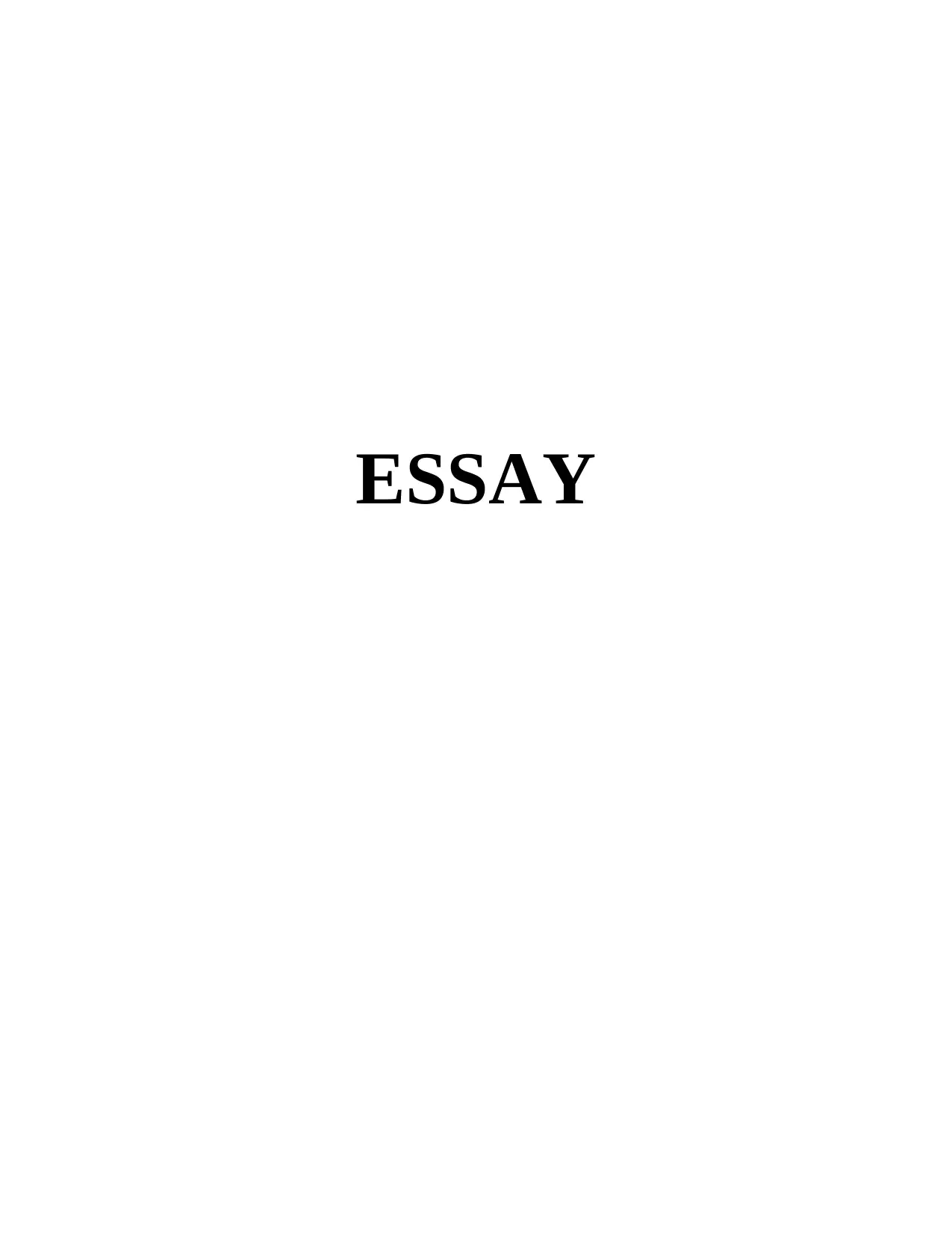
ESSAY
Paraphrase This Document
Need a fresh take? Get an instant paraphrase of this document with our AI Paraphraser
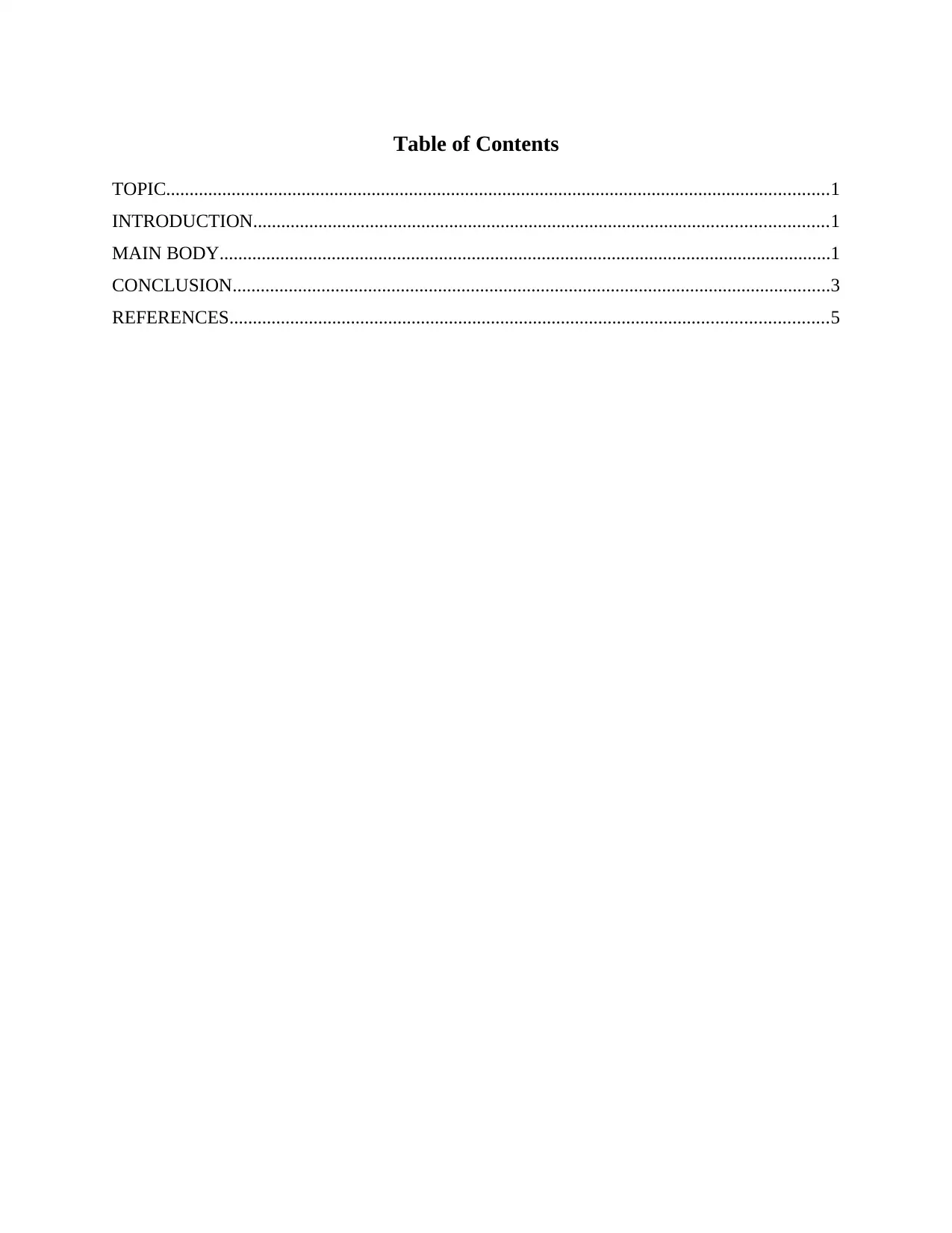
Table of Contents
TOPIC..............................................................................................................................................1
INTRODUCTION...........................................................................................................................1
MAIN BODY...................................................................................................................................1
CONCLUSION................................................................................................................................3
REFERENCES................................................................................................................................5
TOPIC..............................................................................................................................................1
INTRODUCTION...........................................................................................................................1
MAIN BODY...................................................................................................................................1
CONCLUSION................................................................................................................................3
REFERENCES................................................................................................................................5
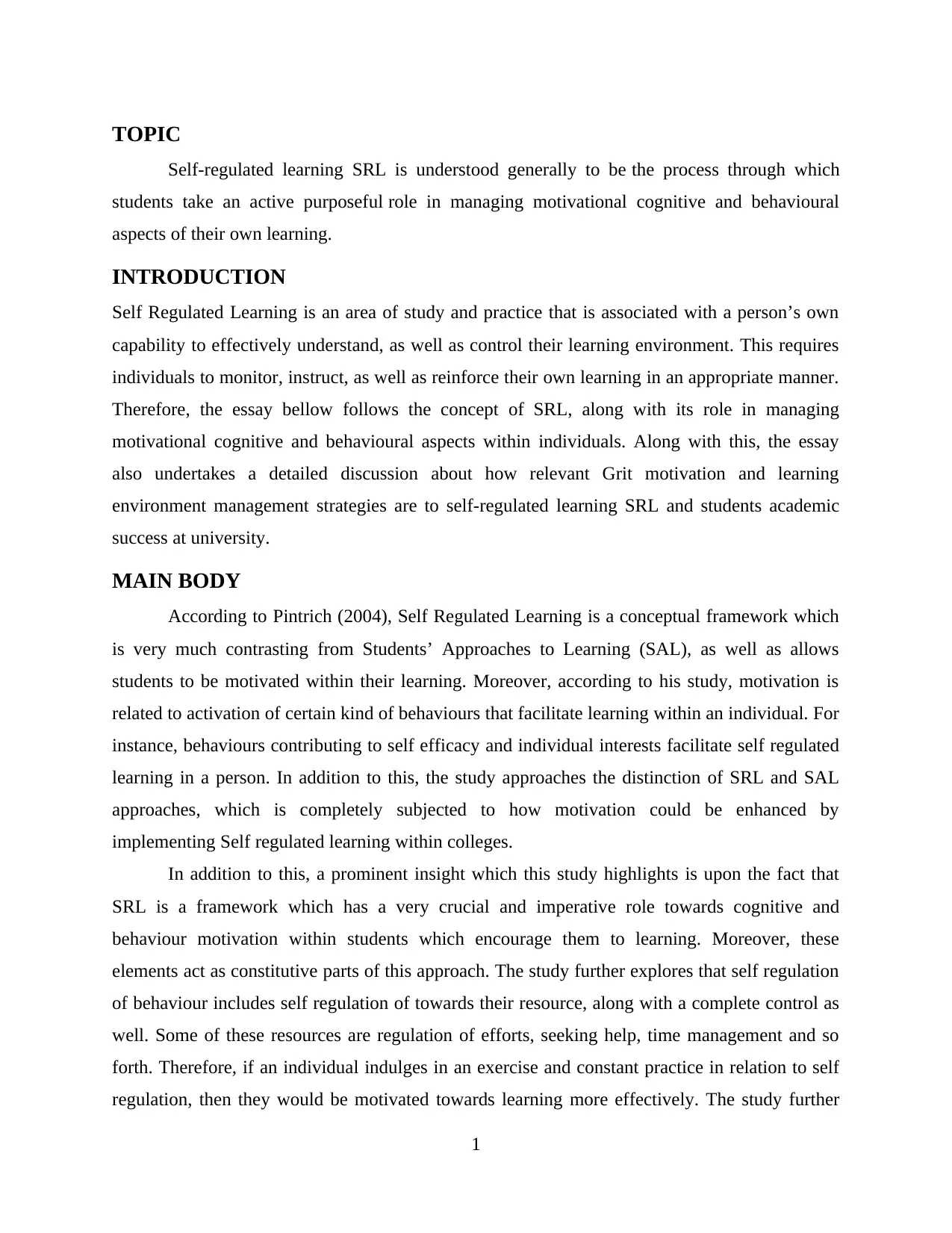
TOPIC
Self-regulated learning SRL is understood generally to be the process through which
students take an active purposeful role in managing motivational cognitive and behavioural
aspects of their own learning.
INTRODUCTION
Self Regulated Learning is an area of study and practice that is associated with a person’s own
capability to effectively understand, as well as control their learning environment. This requires
individuals to monitor, instruct, as well as reinforce their own learning in an appropriate manner.
Therefore, the essay bellow follows the concept of SRL, along with its role in managing
motivational cognitive and behavioural aspects within individuals. Along with this, the essay
also undertakes a detailed discussion about how relevant Grit motivation and learning
environment management strategies are to self-regulated learning SRL and students academic
success at university.
MAIN BODY
According to Pintrich (2004), Self Regulated Learning is a conceptual framework which
is very much contrasting from Students’ Approaches to Learning (SAL), as well as allows
students to be motivated within their learning. Moreover, according to his study, motivation is
related to activation of certain kind of behaviours that facilitate learning within an individual. For
instance, behaviours contributing to self efficacy and individual interests facilitate self regulated
learning in a person. In addition to this, the study approaches the distinction of SRL and SAL
approaches, which is completely subjected to how motivation could be enhanced by
implementing Self regulated learning within colleges.
In addition to this, a prominent insight which this study highlights is upon the fact that
SRL is a framework which has a very crucial and imperative role towards cognitive and
behaviour motivation within students which encourage them to learning. Moreover, these
elements act as constitutive parts of this approach. The study further explores that self regulation
of behaviour includes self regulation of towards their resource, along with a complete control as
well. Some of these resources are regulation of efforts, seeking help, time management and so
forth. Therefore, if an individual indulges in an exercise and constant practice in relation to self
regulation, then they would be motivated towards learning more effectively. The study further
1
Self-regulated learning SRL is understood generally to be the process through which
students take an active purposeful role in managing motivational cognitive and behavioural
aspects of their own learning.
INTRODUCTION
Self Regulated Learning is an area of study and practice that is associated with a person’s own
capability to effectively understand, as well as control their learning environment. This requires
individuals to monitor, instruct, as well as reinforce their own learning in an appropriate manner.
Therefore, the essay bellow follows the concept of SRL, along with its role in managing
motivational cognitive and behavioural aspects within individuals. Along with this, the essay
also undertakes a detailed discussion about how relevant Grit motivation and learning
environment management strategies are to self-regulated learning SRL and students academic
success at university.
MAIN BODY
According to Pintrich (2004), Self Regulated Learning is a conceptual framework which
is very much contrasting from Students’ Approaches to Learning (SAL), as well as allows
students to be motivated within their learning. Moreover, according to his study, motivation is
related to activation of certain kind of behaviours that facilitate learning within an individual. For
instance, behaviours contributing to self efficacy and individual interests facilitate self regulated
learning in a person. In addition to this, the study approaches the distinction of SRL and SAL
approaches, which is completely subjected to how motivation could be enhanced by
implementing Self regulated learning within colleges.
In addition to this, a prominent insight which this study highlights is upon the fact that
SRL is a framework which has a very crucial and imperative role towards cognitive and
behaviour motivation within students which encourage them to learning. Moreover, these
elements act as constitutive parts of this approach. The study further explores that self regulation
of behaviour includes self regulation of towards their resource, along with a complete control as
well. Some of these resources are regulation of efforts, seeking help, time management and so
forth. Therefore, if an individual indulges in an exercise and constant practice in relation to self
regulation, then they would be motivated towards learning more effectively. The study further
1
⊘ This is a preview!⊘
Do you want full access?
Subscribe today to unlock all pages.

Trusted by 1+ million students worldwide
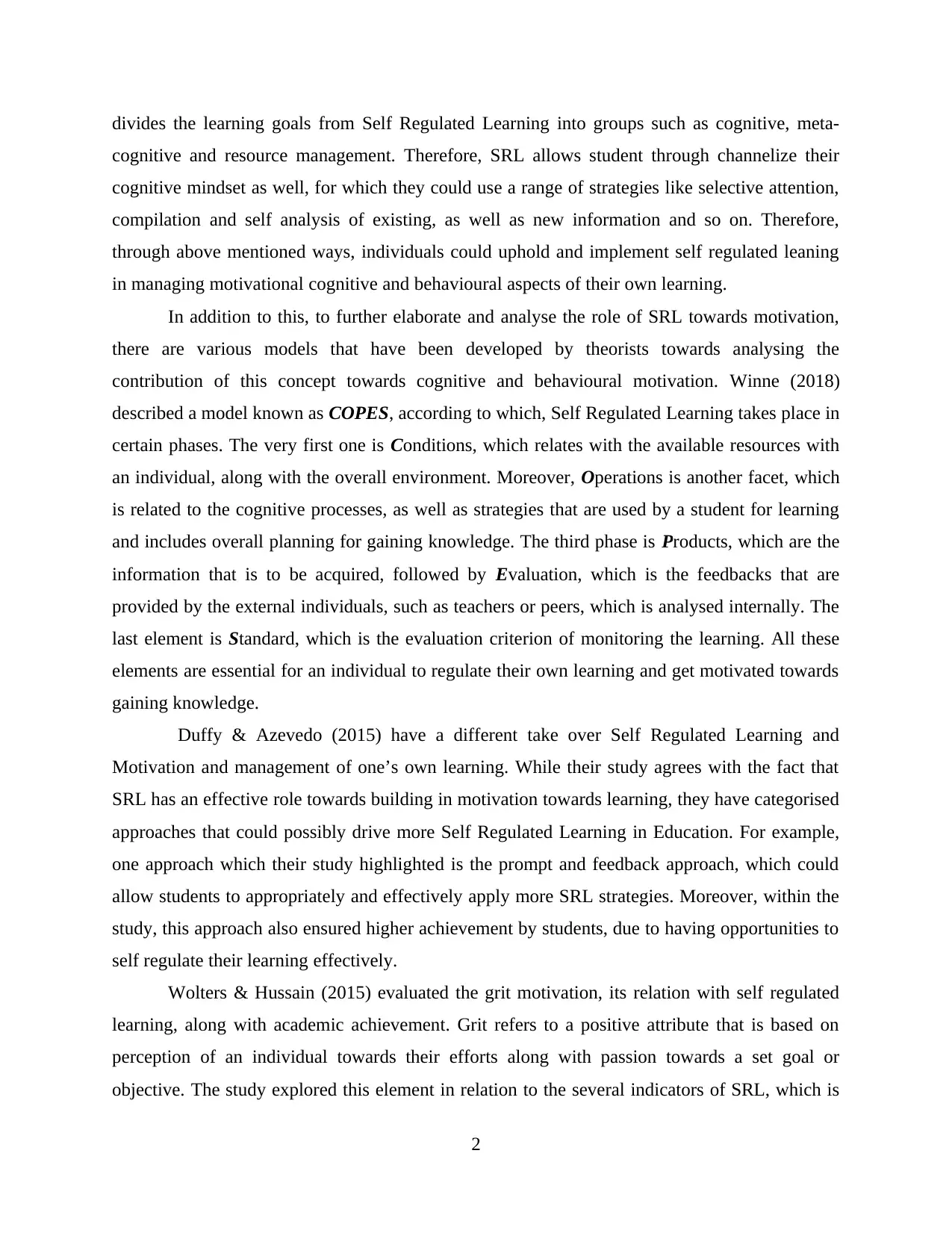
divides the learning goals from Self Regulated Learning into groups such as cognitive, meta-
cognitive and resource management. Therefore, SRL allows student through channelize their
cognitive mindset as well, for which they could use a range of strategies like selective attention,
compilation and self analysis of existing, as well as new information and so on. Therefore,
through above mentioned ways, individuals could uphold and implement self regulated leaning
in managing motivational cognitive and behavioural aspects of their own learning.
In addition to this, to further elaborate and analyse the role of SRL towards motivation,
there are various models that have been developed by theorists towards analysing the
contribution of this concept towards cognitive and behavioural motivation. Winne (2018)
described a model known as COPES, according to which, Self Regulated Learning takes place in
certain phases. The very first one is Conditions, which relates with the available resources with
an individual, along with the overall environment. Moreover, Operations is another facet, which
is related to the cognitive processes, as well as strategies that are used by a student for learning
and includes overall planning for gaining knowledge. The third phase is Products, which are the
information that is to be acquired, followed by Evaluation, which is the feedbacks that are
provided by the external individuals, such as teachers or peers, which is analysed internally. The
last element is Standard, which is the evaluation criterion of monitoring the learning. All these
elements are essential for an individual to regulate their own learning and get motivated towards
gaining knowledge.
Duffy & Azevedo (2015) have a different take over Self Regulated Learning and
Motivation and management of one’s own learning. While their study agrees with the fact that
SRL has an effective role towards building in motivation towards learning, they have categorised
approaches that could possibly drive more Self Regulated Learning in Education. For example,
one approach which their study highlighted is the prompt and feedback approach, which could
allow students to appropriately and effectively apply more SRL strategies. Moreover, within the
study, this approach also ensured higher achievement by students, due to having opportunities to
self regulate their learning effectively.
Wolters & Hussain (2015) evaluated the grit motivation, its relation with self regulated
learning, along with academic achievement. Grit refers to a positive attribute that is based on
perception of an individual towards their efforts along with passion towards a set goal or
objective. The study explored this element in relation to the several indicators of SRL, which is
2
cognitive and resource management. Therefore, SRL allows student through channelize their
cognitive mindset as well, for which they could use a range of strategies like selective attention,
compilation and self analysis of existing, as well as new information and so on. Therefore,
through above mentioned ways, individuals could uphold and implement self regulated leaning
in managing motivational cognitive and behavioural aspects of their own learning.
In addition to this, to further elaborate and analyse the role of SRL towards motivation,
there are various models that have been developed by theorists towards analysing the
contribution of this concept towards cognitive and behavioural motivation. Winne (2018)
described a model known as COPES, according to which, Self Regulated Learning takes place in
certain phases. The very first one is Conditions, which relates with the available resources with
an individual, along with the overall environment. Moreover, Operations is another facet, which
is related to the cognitive processes, as well as strategies that are used by a student for learning
and includes overall planning for gaining knowledge. The third phase is Products, which are the
information that is to be acquired, followed by Evaluation, which is the feedbacks that are
provided by the external individuals, such as teachers or peers, which is analysed internally. The
last element is Standard, which is the evaluation criterion of monitoring the learning. All these
elements are essential for an individual to regulate their own learning and get motivated towards
gaining knowledge.
Duffy & Azevedo (2015) have a different take over Self Regulated Learning and
Motivation and management of one’s own learning. While their study agrees with the fact that
SRL has an effective role towards building in motivation towards learning, they have categorised
approaches that could possibly drive more Self Regulated Learning in Education. For example,
one approach which their study highlighted is the prompt and feedback approach, which could
allow students to appropriately and effectively apply more SRL strategies. Moreover, within the
study, this approach also ensured higher achievement by students, due to having opportunities to
self regulate their learning effectively.
Wolters & Hussain (2015) evaluated the grit motivation, its relation with self regulated
learning, along with academic achievement. Grit refers to a positive attribute that is based on
perception of an individual towards their efforts along with passion towards a set goal or
objective. The study explored this element in relation to the several indicators of SRL, which is
2
Paraphrase This Document
Need a fresh take? Get an instant paraphrase of this document with our AI Paraphraser
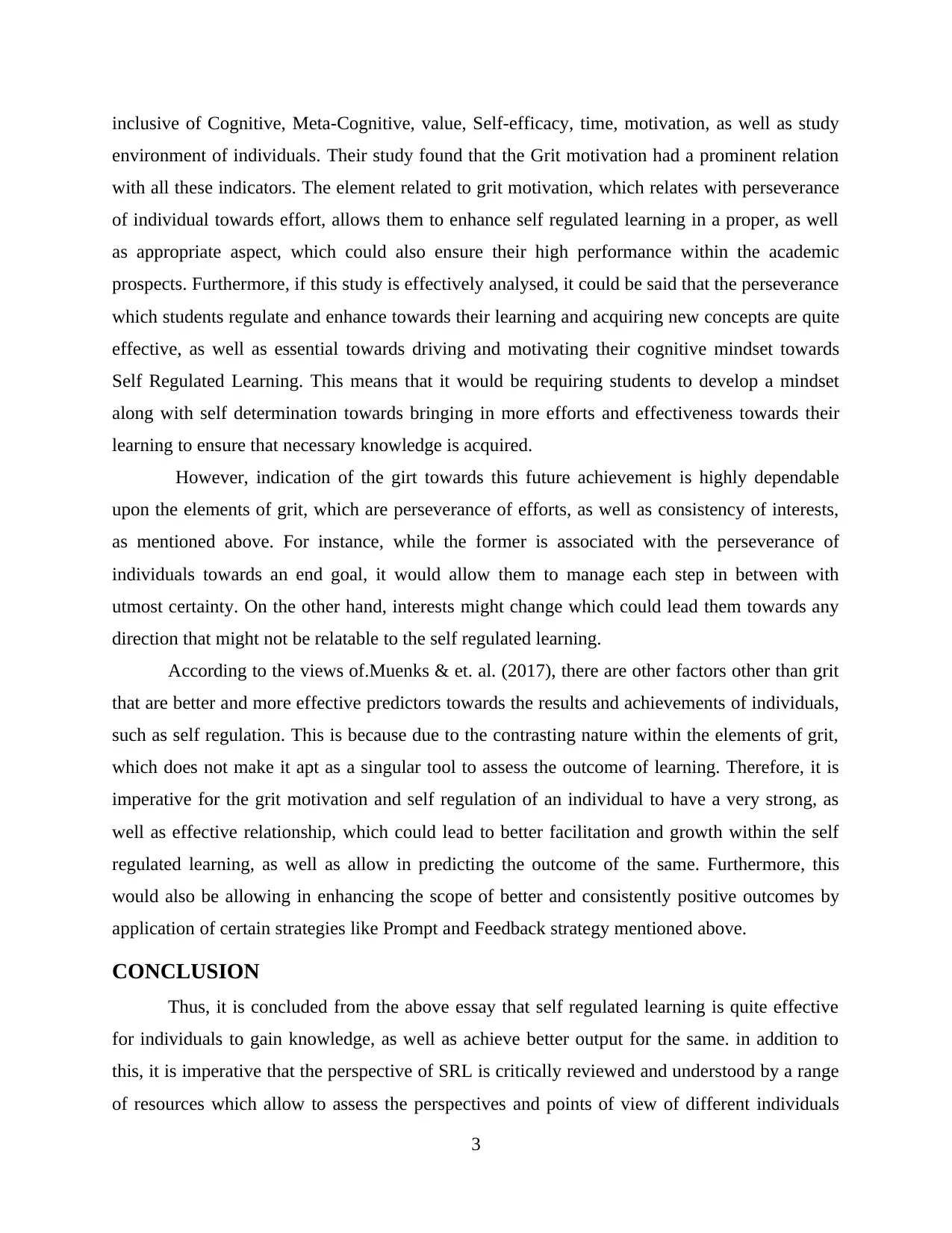
inclusive of Cognitive, Meta-Cognitive, value, Self-efficacy, time, motivation, as well as study
environment of individuals. Their study found that the Grit motivation had a prominent relation
with all these indicators. The element related to grit motivation, which relates with perseverance
of individual towards effort, allows them to enhance self regulated learning in a proper, as well
as appropriate aspect, which could also ensure their high performance within the academic
prospects. Furthermore, if this study is effectively analysed, it could be said that the perseverance
which students regulate and enhance towards their learning and acquiring new concepts are quite
effective, as well as essential towards driving and motivating their cognitive mindset towards
Self Regulated Learning. This means that it would be requiring students to develop a mindset
along with self determination towards bringing in more efforts and effectiveness towards their
learning to ensure that necessary knowledge is acquired.
However, indication of the girt towards this future achievement is highly dependable
upon the elements of grit, which are perseverance of efforts, as well as consistency of interests,
as mentioned above. For instance, while the former is associated with the perseverance of
individuals towards an end goal, it would allow them to manage each step in between with
utmost certainty. On the other hand, interests might change which could lead them towards any
direction that might not be relatable to the self regulated learning.
According to the views of.Muenks & et. al. (2017), there are other factors other than grit
that are better and more effective predictors towards the results and achievements of individuals,
such as self regulation. This is because due to the contrasting nature within the elements of grit,
which does not make it apt as a singular tool to assess the outcome of learning. Therefore, it is
imperative for the grit motivation and self regulation of an individual to have a very strong, as
well as effective relationship, which could lead to better facilitation and growth within the self
regulated learning, as well as allow in predicting the outcome of the same. Furthermore, this
would also be allowing in enhancing the scope of better and consistently positive outcomes by
application of certain strategies like Prompt and Feedback strategy mentioned above.
CONCLUSION
Thus, it is concluded from the above essay that self regulated learning is quite effective
for individuals to gain knowledge, as well as achieve better output for the same. in addition to
this, it is imperative that the perspective of SRL is critically reviewed and understood by a range
of resources which allow to assess the perspectives and points of view of different individuals
3
environment of individuals. Their study found that the Grit motivation had a prominent relation
with all these indicators. The element related to grit motivation, which relates with perseverance
of individual towards effort, allows them to enhance self regulated learning in a proper, as well
as appropriate aspect, which could also ensure their high performance within the academic
prospects. Furthermore, if this study is effectively analysed, it could be said that the perseverance
which students regulate and enhance towards their learning and acquiring new concepts are quite
effective, as well as essential towards driving and motivating their cognitive mindset towards
Self Regulated Learning. This means that it would be requiring students to develop a mindset
along with self determination towards bringing in more efforts and effectiveness towards their
learning to ensure that necessary knowledge is acquired.
However, indication of the girt towards this future achievement is highly dependable
upon the elements of grit, which are perseverance of efforts, as well as consistency of interests,
as mentioned above. For instance, while the former is associated with the perseverance of
individuals towards an end goal, it would allow them to manage each step in between with
utmost certainty. On the other hand, interests might change which could lead them towards any
direction that might not be relatable to the self regulated learning.
According to the views of.Muenks & et. al. (2017), there are other factors other than grit
that are better and more effective predictors towards the results and achievements of individuals,
such as self regulation. This is because due to the contrasting nature within the elements of grit,
which does not make it apt as a singular tool to assess the outcome of learning. Therefore, it is
imperative for the grit motivation and self regulation of an individual to have a very strong, as
well as effective relationship, which could lead to better facilitation and growth within the self
regulated learning, as well as allow in predicting the outcome of the same. Furthermore, this
would also be allowing in enhancing the scope of better and consistently positive outcomes by
application of certain strategies like Prompt and Feedback strategy mentioned above.
CONCLUSION
Thus, it is concluded from the above essay that self regulated learning is quite effective
for individuals to gain knowledge, as well as achieve better output for the same. in addition to
this, it is imperative that the perspective of SRL is critically reviewed and understood by a range
of resources which allow to assess the perspectives and points of view of different individuals
3
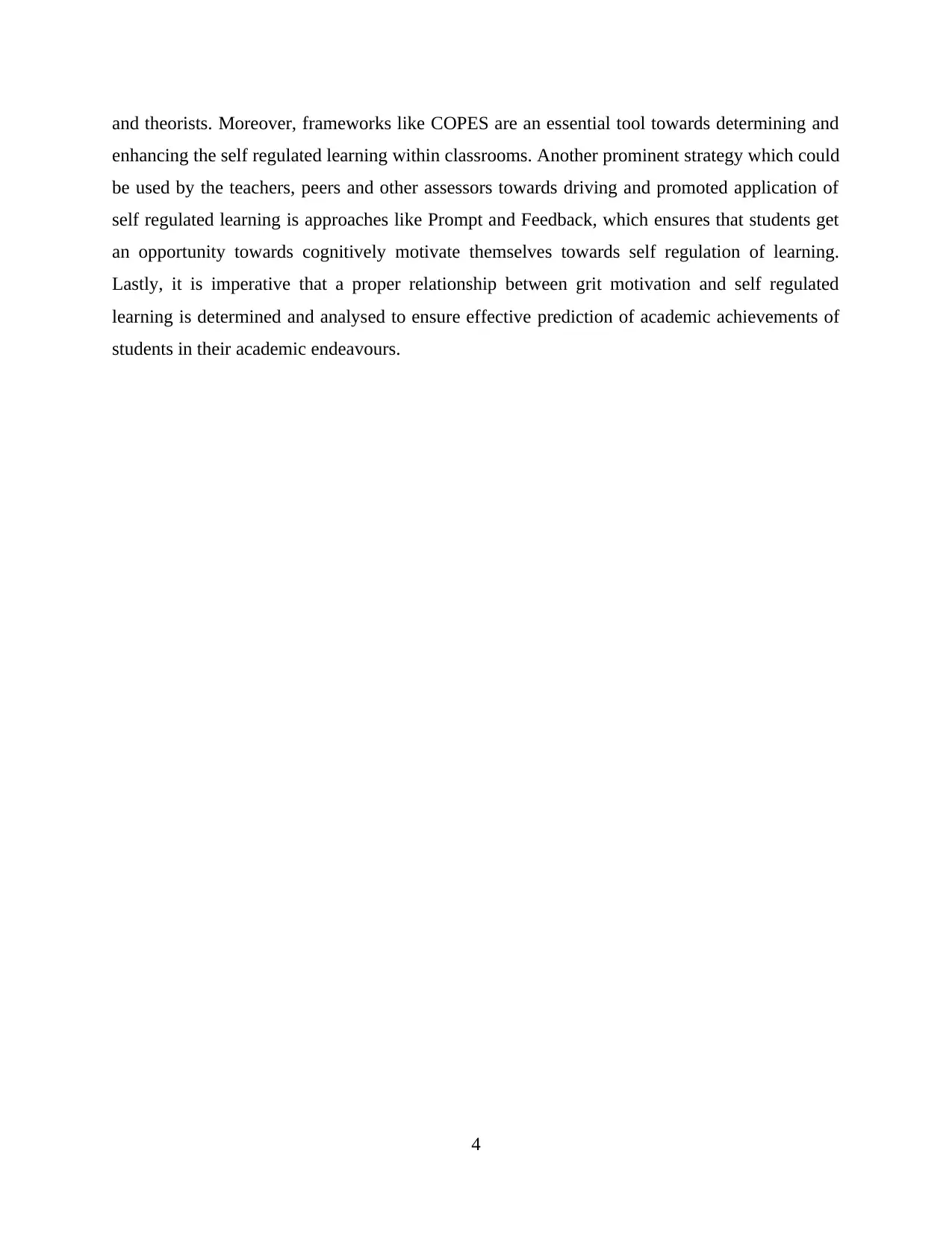
and theorists. Moreover, frameworks like COPES are an essential tool towards determining and
enhancing the self regulated learning within classrooms. Another prominent strategy which could
be used by the teachers, peers and other assessors towards driving and promoted application of
self regulated learning is approaches like Prompt and Feedback, which ensures that students get
an opportunity towards cognitively motivate themselves towards self regulation of learning.
Lastly, it is imperative that a proper relationship between grit motivation and self regulated
learning is determined and analysed to ensure effective prediction of academic achievements of
students in their academic endeavours.
4
enhancing the self regulated learning within classrooms. Another prominent strategy which could
be used by the teachers, peers and other assessors towards driving and promoted application of
self regulated learning is approaches like Prompt and Feedback, which ensures that students get
an opportunity towards cognitively motivate themselves towards self regulation of learning.
Lastly, it is imperative that a proper relationship between grit motivation and self regulated
learning is determined and analysed to ensure effective prediction of academic achievements of
students in their academic endeavours.
4
⊘ This is a preview!⊘
Do you want full access?
Subscribe today to unlock all pages.

Trusted by 1+ million students worldwide
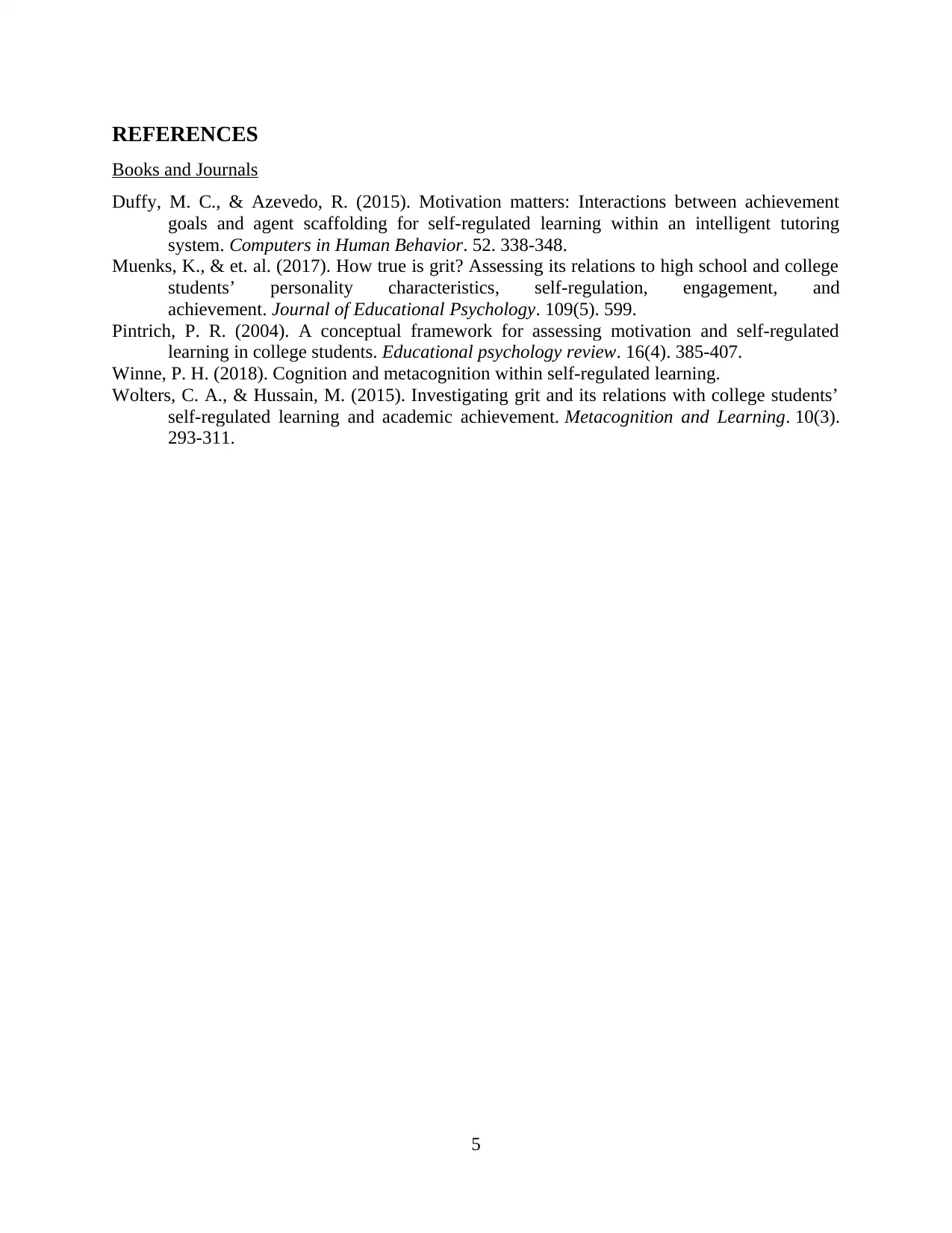
REFERENCES
Books and Journals
Duffy, M. C., & Azevedo, R. (2015). Motivation matters: Interactions between achievement
goals and agent scaffolding for self-regulated learning within an intelligent tutoring
system. Computers in Human Behavior. 52. 338-348.
Muenks, K., & et. al. (2017). How true is grit? Assessing its relations to high school and college
students’ personality characteristics, self-regulation, engagement, and
achievement. Journal of Educational Psychology. 109(5). 599.
Pintrich, P. R. (2004). A conceptual framework for assessing motivation and self-regulated
learning in college students. Educational psychology review. 16(4). 385-407.
Winne, P. H. (2018). Cognition and metacognition within self-regulated learning.
Wolters, C. A., & Hussain, M. (2015). Investigating grit and its relations with college students’
self-regulated learning and academic achievement. Metacognition and Learning. 10(3).
293-311.
5
Books and Journals
Duffy, M. C., & Azevedo, R. (2015). Motivation matters: Interactions between achievement
goals and agent scaffolding for self-regulated learning within an intelligent tutoring
system. Computers in Human Behavior. 52. 338-348.
Muenks, K., & et. al. (2017). How true is grit? Assessing its relations to high school and college
students’ personality characteristics, self-regulation, engagement, and
achievement. Journal of Educational Psychology. 109(5). 599.
Pintrich, P. R. (2004). A conceptual framework for assessing motivation and self-regulated
learning in college students. Educational psychology review. 16(4). 385-407.
Winne, P. H. (2018). Cognition and metacognition within self-regulated learning.
Wolters, C. A., & Hussain, M. (2015). Investigating grit and its relations with college students’
self-regulated learning and academic achievement. Metacognition and Learning. 10(3).
293-311.
5
1 out of 7
Related Documents
Your All-in-One AI-Powered Toolkit for Academic Success.
+13062052269
info@desklib.com
Available 24*7 on WhatsApp / Email
![[object Object]](/_next/static/media/star-bottom.7253800d.svg)
Unlock your academic potential
Copyright © 2020–2025 A2Z Services. All Rights Reserved. Developed and managed by ZUCOL.





